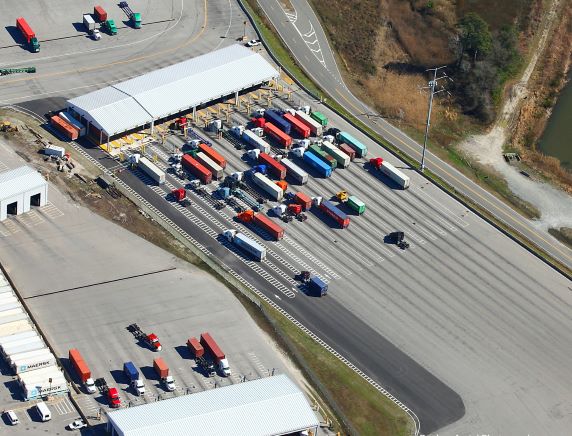Archives
Freight News, Road, Sea
TRS Drives Productivity at POV, Creates Flow at the Gates; System Marks One Year of Operation
[ March 22, 2019 // Gary G Burrows ]Motor carriers using The Port of Virginia’s® Truck Reservation System (TRS) are seeing an ongoing reduction in their turn times, evidence the technology is helping to drive the efficient movement of cargo at the port’s two main container terminals, says the port’s chief executive.
“This is a twenty-first century tool designed to drive efficiency and the numbers prove it,” says John F. Reinhart, the CEO and executive director of the Virginia Port Authority. “Drivers that are taking advantage of this technology are getting in-and-out of our terminals quicker than ever before. TRS allows us to better manage flow at our gates; it gives even greater visibility to cargo owners and has matured into an important planning tool for us and everyone who moves cargo by truck.”
Following more than two years of collaborative development with the local motor carrier community, the port launched TRS in March 2018 at Norfolk International Terminals (NIT) and in June 2018 at Virginia International Gateway (VIG). In TRS’ early days, there were only a few mandatory hours per day, per terminal. Now the system is a vital component of daily port operations and is in use from the time the terminals open (5 a.m. at NIT and 3 a.m. at VIG) until 1 p.m.
Exactly a year later, TRS mandatory hours account for nearly 100 gate hours per week at NIT and Virginia International Gateway (VIG), covering more than 70% of available truck gate capacity at both terminals. The system is designed to complement and enhance the efficiencies produced by the semi-automated container stacks, improving overall results for truckers, beneficial cargo owners and the port.
TRS facts since its debut:
• 292,588 reservations completed since March 1, 2018 • An average of 567 reservations completed per day at NIT o Resulting in a 16% reduction in turn times • An average of 765 reservations completed per day at VIG o Resulting in a 32% reduction in turn times
“Rush-hour is not an option,” Reinhart says. ‘Spreading out the truck volume across the day is the only way to achieve efficiency, and we’ve developed an innovative, fair, easy and useful means of accomplishing that.”
The system is a critical component in the management of trucks moving to and from NIT and VIG. At those terminals, the port is investing a combined $700 million to expand capacity. At VIG, the port is doubling the terminal’s annual throughput capacity to 1.2 million container lifts, and across the river at NIT, capacity is being expanded by 46%, or 400,000 annual lifts.
At VIG, the work is nearly complete. The 13 new stacks served by 26 new rail-mounted gantry cranes (RMGs) are fully operational as are four new lanes at the gate for motor carriers. With the stack-yard work complete and the RMGs fully operational, the process of refurbishing VIG’s original RMGs is underway. The final phase of the rail yard expansion and bringing four new ship-to-shore cranes into service are the final pieces; all work will be finished in June. The work at NIT is well underway, and 12 new stacks served by 24 RMGs went into service in February; 18 additional stacks will be completed in phases through late 2020.
“Our volumes are growing, and it’s a trend that will continue,” Reinhart says. “Creating predictability and efficiency at our gates from hour-to-hour is the goal. We know there will be challenges ahead, and our team is well-prepared with technology and solutions. We’ll soon be expanding the number of hours available for reservations and continuing to tweak TRS as we go forward to ensure it meets its goal and proves beneficial to all users.”
At VIG (pictured) an average of 765 reservations per day are completed resulting in a 32% reduction in turn times at that terminal. (Port of Virginia photo.)
Tags: The Port of Virginia’s®









